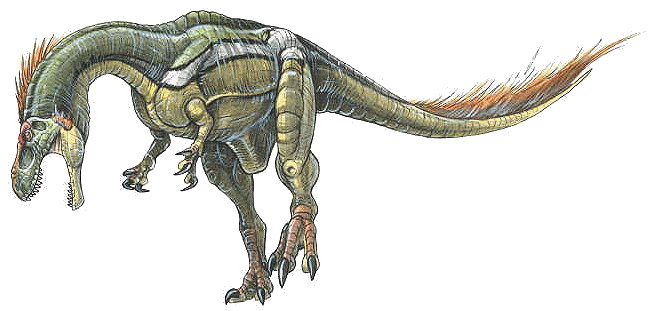|
|
 |
|
Eotyrannus lengi
(Hutt, Naish,
Martill, Barker and Newbery 2001) |
|

|
|
Name Means: |
"Early Tyrant" |
Length: |
12 feet (4 meters) |
|
Pronounced: |
Ee-oh-tie-RAN-uss |
Weight: |
Unknown |
|
When it lived: |
120-125 million years ago |
|
|
|
Where found: |
Isle of Wight, Britain |
|
|
|
|
Discovery |
On May 9, 2001 an important new discovery was announced. It was
previously unknown tyrannosaur extracted from the Wessex formation, in
concrete-like mudstone up on a high cliff face at Brighstone Bay on
the Isle of Wight. The new species was much smaller than
Tyrannosaurus but the skull, shoulder and limbs were similar.
Paleontologists described the discovery as one of the most
important archaeological finds made in Britain.Martin Munt, acting
curator of the Museum of Isle of Wight Geology which is coordinating
the dig, said that it was an important piece in the evolutionary
jigsaw of T-rex. "The remains start to fill in the family tree
of life. They are a missing link. The T-rex was around 60 to 70
million years ago. At that time this skeleton was already 55 million
years old," Munt added, "We are really pushing back to the origins of
the group of dinosaurs that gave us T-rex."
The first bones were found in 1997 on a cliff top near the
village of Brightstone, near Newport, and the name "lengi" honors Leng,
who fit. It took four years to fully excavate the site and analyze the
findings.
Darren Naish of the University of Portsmouth, who is part of
a five-member team examining the remains, said 40% of the skeleton had
been discovered. He said that was enough to determine it was an
entirely new species. He was quoted as saying, "Eotyrannus lengi
is one of the most complete and most globally important predatory
dinosaurs of this age that has been found. It gives us a lot of
information about the early evolution of the tyrannosaur that we did
not know before...It also gives us a lot of information about the
diversity of dinosaurs at this time in Europe."
The later tyrannosaurs, including T-rex, stalked North
America and Asia in the late Cretaceous period, about 65 million years
ago. They were 38-feet-long, had huge heads with powerful jaws and
tiny forearms and relied on teeth alone to kill their prey.
Although much smaller, the Eotyrannus had a similar skull, shoulder
and limb structure. It would have been a fast, agile predator, preying
mainly on species such as Valdosaurus and Hypsilophodon, also found on
the Isle of Wight. Naish said the new species may also be
closely related to the Velociraptor, a 6-foot-long predator of the
mid-Cretaceous period, around 90 million years ago, which was made
famous by the movie "Jurassic Park." He said its small head,
long powerful arms and sharp claws were very similar to those of
Eotyrannus. |
|
Anatomical Details |
The
bones are quite fragile and they are entombed in a very hard matrix.
but scientists have been able to determine that the teeth in the
premaxilla are D-shaped in cross-section, with denticulations that
continue over the tip and the rostral carinae bear denticles for less
than half the length of the denticle-bearing part of the caudal
carinae. There is a denticle size difference index of c. 1.5, with
between 13-20 denticles per 5mm. The premaxilla is blunt with a
vertical anterior border and the maxilla is peculiar in that it has a
posteriodorsally located antorbital fossa border, with the part of the
maxilla anterior to this laterally flat. The nasals are fused.
The manus is elongate and slender, with digit II nearly 95%
the length of the humerus, and has three well-developed metacarpals,
and the hindlimbs are gracile. The carpals not reduced to simple
elements as in tyrannosaurids.The humerus has a well-developed
deltopectoral crest and there are a series of internal hollows. The
coracoid has a prominent mediolaterally-wide, subcircular glenoid
directed caudally, but the coracoid foramen is absent. The tibia is
elongate with a weakly developed cnemial crest (projecting process on
the proximal part of the front surface of the tibia, to which lower
leg muscles are attached) and a robust fibular crest.
Lack of element fusion elsewhere in the skeleton suggests
that it is a subadult. If so then a full-grown adult may have
been considerably larger. |
|
|
|
|
|
|
|
|
Edugraphics.Net | Feenixx Publishing |
|
|
|
|
|

